Here is the Volume 4 of Hockey from When you watch something, visit us first! Mr. Manabu YAMASHITA, former Coach of Japanese men’s national Hockey team “Samurai Japan”, told us about the Theory of Offense in Hockey match this time. This is the combined version of Part 6-1 & 6-2 on our YouTube channel.
In Vol.3, we learned about the Offense and Defense around the Circle.
This time, with the cooperation of Japan Hockey Association, Mr. Manabu YAMASHITA, former Coach of Japanese men’s national Hockey team “Samurai Japan”, told us about the theory of the Offense. Mr. YAMASHITA was the Captain of “Samurai Japan” at Tokyo 2020 Games, and is now back in active and aiming to be a member of it again.
We would like to thank Japan Hockey Association, especially Head Coach of Samurai Japan, Mr. Akira TAKAHASHI, for their great help in making this video. We would like to express our sincere gratitude.
.png)
Part 6-1: How to build up
Basic of Build up
The theory in Hockey is to attack from their own right side. If Offense (OF) starts their attack from this area, if they lose the ball in such deep area of their own territory, it is very close to Circle, so they should not take any risks in such an area of their own territory and should exchange passes safely.
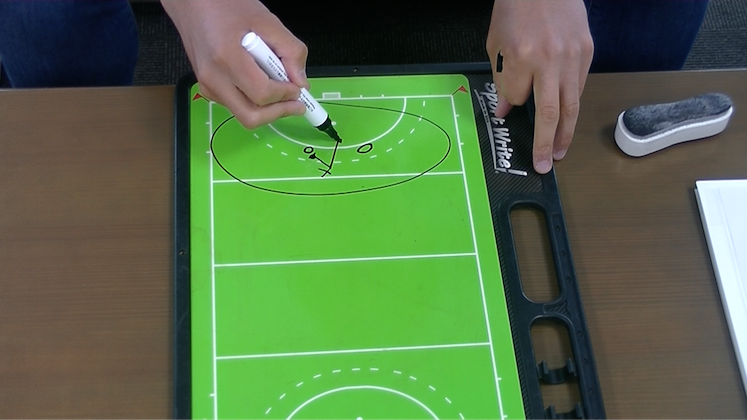
Or, another theory is to attack with a long ball, like with a Scoop ball from the area close to Circle to the far area, with No Risk.
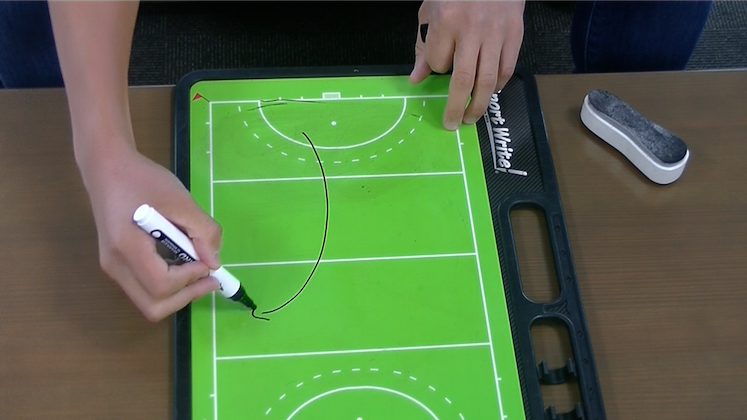
And the theory when they advance to this midfield area is to connect the ball somewhat aggressively, because they can take a little more risk. I think this is a similar concept to Soccer.
Also, in Hockey, the pitch is often divided vertically into two halves, and if the ball is here, the half with the ball is called “Ball side” and the other half is called “Help side,” and more players are in Ball side in many cases, so to connect passes firmly in midfield area to carry the ball to the help side where there is space and to attack from such area where the opponent is not is the current theory of Hockey.
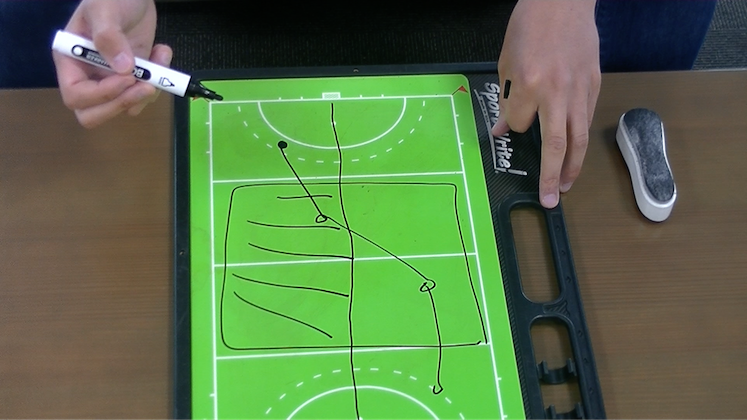
However, if OF does not connect the ball well in this midfield area and tries to connect it with a single pass, Defense (DF) will be able to defend easily, therefore, in this area, OF must attack firmly using a Midfield player or a Side Back player. I think the tactic around here is to take a little more risk than in the deep area of their own.
And finally, when OF get to the vicinity of the opposing team’s Circle, they will be taking risks by aggressively trying to enter the opponent’s Circle.
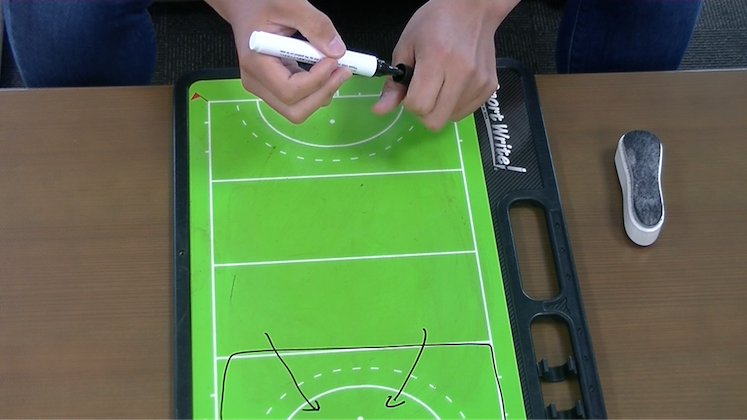
Q: How players decide to use long balls or to connect short passes when escaping from danger area?
It depends on the balance of power with the opponent, but when the opponent presses from a high position as if it is man-to-man basis, and all players are marked tightly, and it is difficult for OF to create a pass courses, if they try to exchange passes by force at risky zone and the ball is taken by the opponent and entered into Circle of their own, the probability of a goal is high, therefore, in such situation, as OF is pressed all over the pitch, they often use long Scoop balls directly into the open space from here.
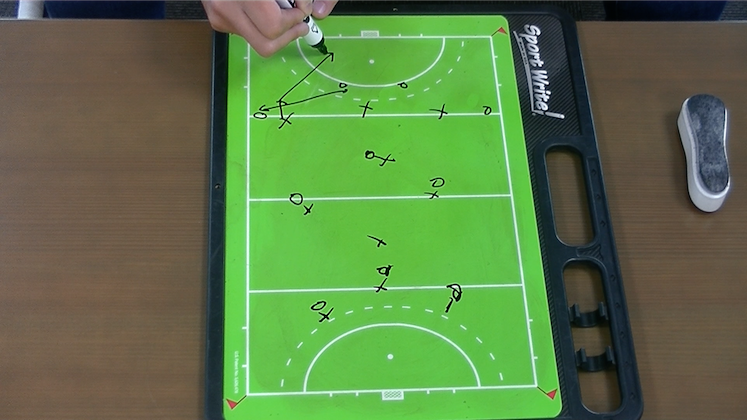
When an OF player passes a Scoop ball from the middle area and if such player makes a mistake, the opponent will pick it up and attack from the middle, so, OF often makes a low-risk pass, such as passing the ball once to the side player and to send a long ball forward, as they can defend in the middle area even if the ball is taken out by the opponent at the outside.
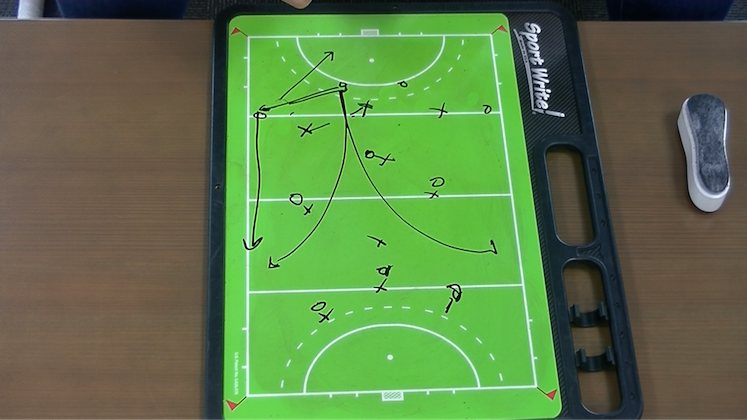
On the other hand, if a team has good skills, i.e., the ability to stop and release the ball, or if a team has excellent individual skills, they can break the situation even if the opposing team presses tightly by repeatedly taking a distance from the opponent and receiving the ball, and then having the side back also moves forward and receives the ball. Some teams attack in this way, using their individual skills to fend off opponents 1-on-1 and to connect to the opposite side or midfield.
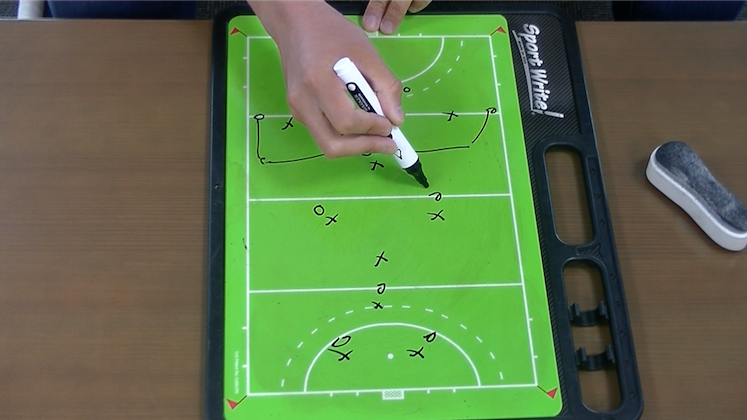
Effect of the lack of Offside rule
There is no Offside rule in Hockey, so if DF players are lined up like this, OF cannot go beyond this point because they are offside in Soccer, however, OF players can enter here in Hockey without any problem. And, when FW go into the deep area, forcing the opposing DF to move back. Well, there is 1 Sweeper.
This creates spaces at both sides like this, and by having midfielders enter these spaces, a large space is then created here, and since there are usually 5 players against 4 the opponent’s players here, it is often to create a numerical advantage and attack from here.
So in soccer, FW cannot go behind DF players, but in Hockey, FW can go deep to open up the midfield area and create space.
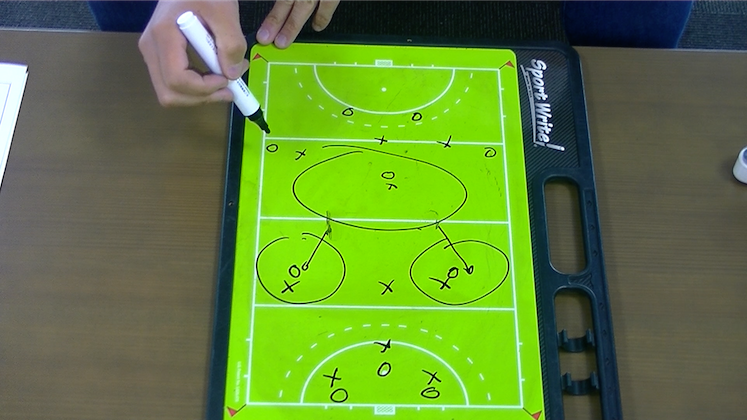
Part 6-2: Tactical Use of Long Ball
Q: Please tell us how to utilize the long ball in Hockey.
In Hockey, the ball is hard and Stick is hard as well, so in order to play safely, the rules are basically set so that the player on the side that enters the drop point first can safely handle the ball.
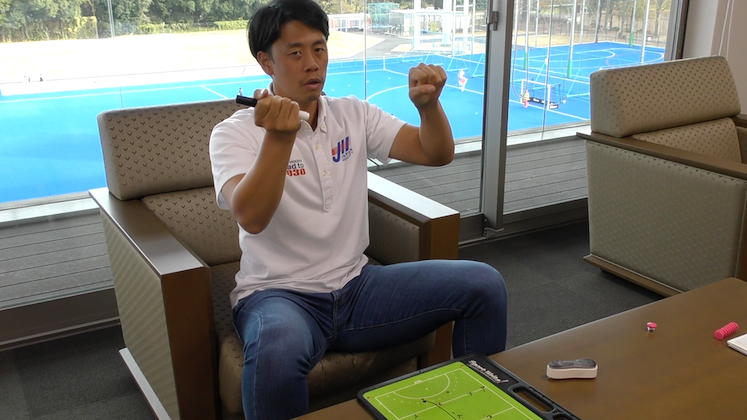
For example, if DF player enters the drop point first when a Scoop ball goes up from here to here, DF side that enters first gets priority because there is a risk of injury if OF disturbs DF there.
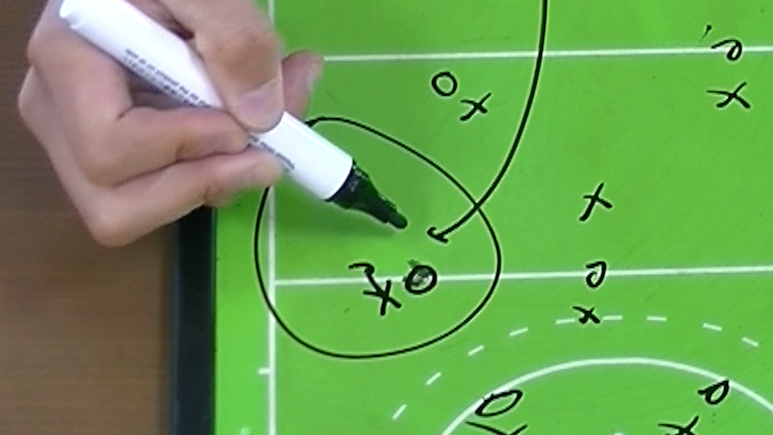
However, the rules have now changed a bit, and basically players who do not have priority must be 5 meters away, but it is allowed to intercept or cut the ball in front of it, as far as they can do it safely. So basically, with such a long ball, DF is more predictable, and I think it is quite common for DF to get into the drop point first and take the ball.
This decision is very difficult to make and can vary slightly from umpire to umpire. When I was an active player, even if I could not enter into the drop point first, I would say, “All right” or “I got it” and then sometimes the priority would be mine. I was a DF player, and sometimes it was judged that this is the drop point when I signaled like this. On the other hand, sometimes the prediction of the drop point is completely wrong and it is quite far back, but that is quite common, just like a Baseball fly.
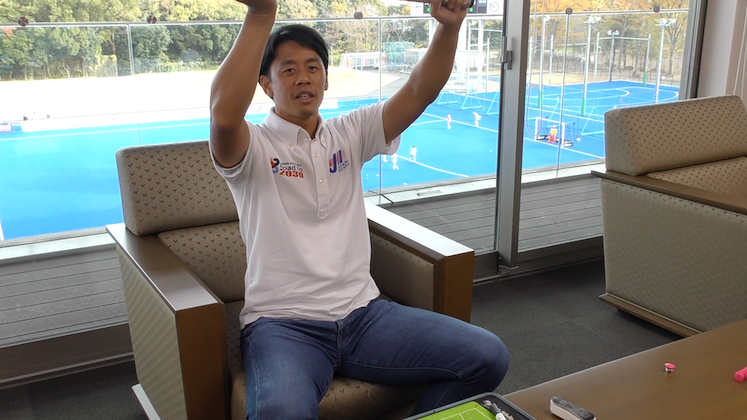
And sometimes a Scoop ball is intentionally placed inside Circle. For example, this FW player will intentionally drop down at the moment when the ball is passed from here with a Scoop ball. If this FW drops back from here and raise the ball pinpoint to that dropped point, it will be a Penalty Corner (PC) if DF comes within 5 meters of the ball because it is a pinpoint ball.
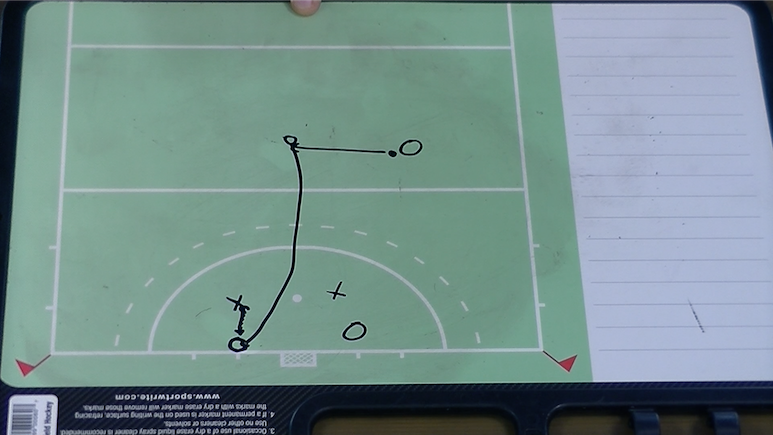
There have been many scenes like this recently, and when the mark is open for a moment, if OF puts the ball in Circle with a high ball to the FW player who has a little distance to DF, DF has to be 5m away, so such FW can control the ball, stop and shoot it immediately, or it can be PC as DF can be in a hurry to respond.
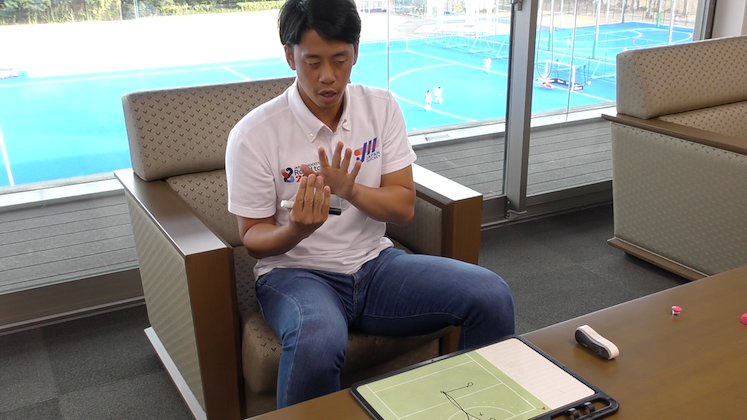
So Scoop ball is used quite tactically these days. A decade ago, it was not so common to put the Scoop ball in Circle.
One of the reasons for this is that the press has changed from man-to-man marking to zone marking around the world. In man-to-man, Scoop ball is not so effective. This is because FW players are being marked by DF players tightly, so it is easy for DF to handle the Scoop ball and to get it back.
However, the recent trend is to use zone marking, so these areas are becoming open. Since in a zone mark, I feel that recently there are many Scoops that are received between DF players, such as when OF players intentionally enter such open areas and play not only a ground ball but also a high ball, taking advantage of the fact that the opponent cannot come within 5 meters to receive it at such a place.
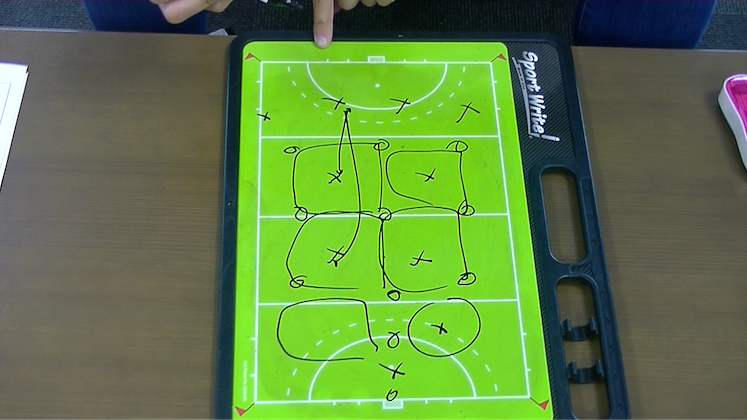
We often use short Scoop balls as well.
Scoop balls are usually long, but in the case of mens players, they can send a Scoop ball for a very long distance.
Some players may send the ball from the top of their own Circle to near the top of the opponents’ Circle with a Scoop ball.
However, the problem is that they may often lose the ball immediately and spend a lot of time on defending.
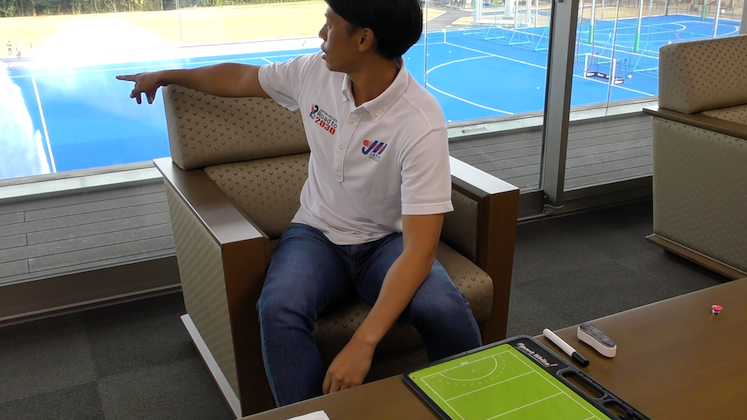
Q: If a player fails to control the long ball even a little bit, they can easily lose the ball to their opponent, am I right?
It is easier to make the opponent to move with keeping the ball. It is tough to react to the opponent. To react continuously is tough, but it is not so hard if we move as we wish.
We were often forced to do that, and as we have to spent so much time on defending, we got tired when we attack, and I think FW substitute in every 3 to 4 minutes because it is quite fatiguing for FW to go for press as well as to score a goal.
Share this content:
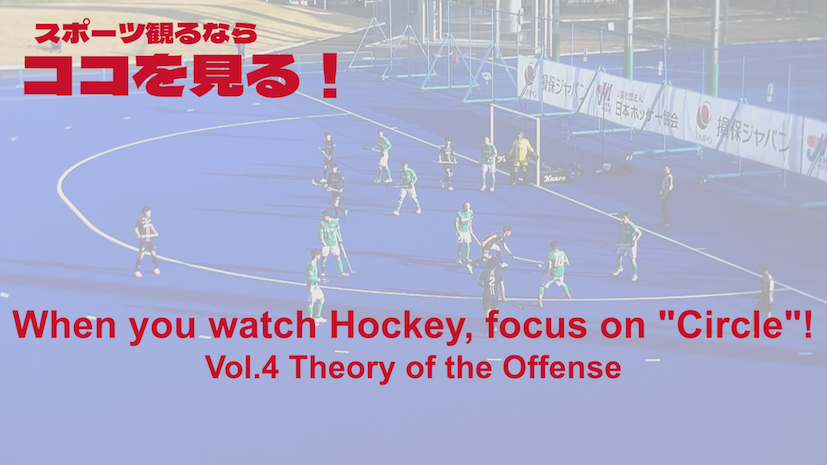
コメントを残す